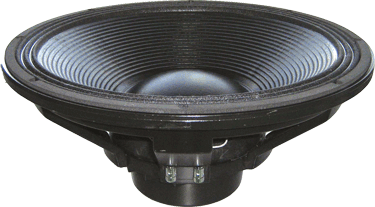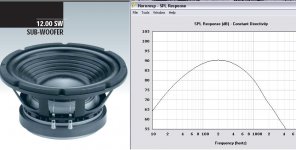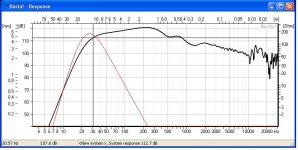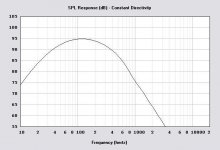I would look at it under two aspects:
1. Is the cone area (including the surround), which is hidden outside the slot, less than 20 % of the whole cone area? In that case I would not bother much.
2. At a crossover frequency < 200 Hz I don`t see any danger of interference.
Apart from that, in my POV, here we are talking about wet hair while sinking in the mid of an ocean.
Rudolf
Thanks for the advice.
The Orion's a groundbreaking speaker but dipole design's progressed in the 10 years since its introduction, so I'd suggest caution in using it as a template.I was hoping that if Linkwitz could get great sound with 2 x 10" maybe I could get close with 2 x 12".
The Orion's a groundbreaking speaker but dipole design's progressed in the 10 years since its introduction, so I'd suggest caution in using it as a template.
Can you point me towards information that I could read to get a better understanding of the subject?
Hmm. Stig Erik's Open Baffle with Beyma TPL150 build thread and the Nao Note thread, both in this forum, have good representation of most of the equalization, baffle, and driver mounting evolution (with more modest SPL and bass extension requirements one can build a quite good nude swinging dipole with 16 fewer drivers than Stik Erik). A couple other points to be aware of are Seas woofers tend to have extra directivity designed in above 500Hz and H and U baffles are perhaps best regarded as poorly shaped horns. Both exacerbate the directivity issues of the Orion's baffle and I would also expect some horn honk. Can't say if there's enough honk to be a problem as the Hornresp simulations I did came out bad enough I chose to avoid a rectilinear baffle.
Baffle hole smaller than cone? Yes, that's been done, a lot. Think Ripole bass.
Restricted area in front of the cone would load it slightly more than free air, so the fs would drop - a good thing. And then it forms a bandpass and restricts the higher range - depends on the application, mostly a good thing, too. If the restriction is too much, to a point, efficiency suffer - a bad thing.
So, it's OK to try.
But it's not helping to the 'bulkiness' I guess, no?
Restricted area in front of the cone would load it slightly more than free air, so the fs would drop - a good thing. And then it forms a bandpass and restricts the higher range - depends on the application, mostly a good thing, too. If the restriction is too much, to a point, efficiency suffer - a bad thing.
So, it's OK to try.
But it's not helping to the 'bulkiness' I guess, no?
You might want to check out my build.... see if that is interesting to you. You could easily use 12" instead of 10"
I'm really happy with it.
http://www.diyaudio.com/forums/multi-way/174745-my-fully-active-4-way-ob-8-drivers-15-subwoofer.html
I'm really happy with it.
http://www.diyaudio.com/forums/multi-way/174745-my-fully-active-4-way-ob-8-drivers-15-subwoofer.html
...
The other issue I have with Altec, is the pair of 15" I paid a lot of money for & a LOT of postage for get here from the US didn't live up to the description that the seller had on ebay, and he had a 100% reputation. I figure I shouldn't have that issue with new speakers, hopefully
Altec 416 is a highly regarded woofer.
However, operating on OB, it's a whole lot different from what it's designed for. Its intrinsic Q is too low for OB.
If this major point isn't solved, you won't have much luck in other woofers.
For your reference:
http://www.diyaudio.com/forums/full-range/130679-t-bass-drive-ob-lf-drivers.html
http://www.diyaudio.com/forums/multi-way/155022-low-q-woofer-ob-high-zo-amp.html
You might want to check out my build.... see if that is interesting to you. You could easily use 12" instead of 10"
I'm really happy with it.
http://www.diyaudio.com/forums/multi-way/174745-my-fully-active-4-way-ob-8-drivers-15-subwoofer.html
I have been following your thread with interest. Keep up the good work.
In the first instance I was to stay passive 3 way, then go active depending on funds & success levels. One thing at a time.
Found a hefty pro 12" xmax 11,5mm 490*1,15 = 563cm^3.
http://www.speakerstore.nl/luidsprekers/Ciare/pdf/12.00SW.pdf
http://www.speakerstore.nl/luidsprekers/Ciare/pdf/12.00SW.pdf
Attachments
here you go,
6 drivers per side - Tymphany lat 500's approximate width about 14 inches, 6 inches high so total height about 3 ft perfect to perch a midrange on top. measurements done with basta open baffle just under xmax with a 20hz 4th order cut and 50volts or 600w into 4ohms and this is with room gain.
and this is with room gain.
probably about the only way to get enough drivers in such a narrow baffle to do the job oh and i added 10cm wings on each side for a little bit of u shape and lift.
personally i use 2 15" 0.92 qts drivers per side in a 50cm by 90cm baffle (no wings) and get 100db with 100w
6 drivers per side - Tymphany lat 500's approximate width about 14 inches, 6 inches high so total height about 3 ft perfect to perch a midrange on top. measurements done with basta open baffle just under xmax with a 20hz 4th order cut and 50volts or 600w into 4ohms
probably about the only way to get enough drivers in such a narrow baffle to do the job oh and i added 10cm wings on each side for a little bit of u shape and lift.
personally i use 2 15" 0.92 qts drivers per side in a 50cm by 90cm baffle (no wings) and get 100db with 100w
Attachments
What about 21" and a xmax of 15mm. 1734*1,5= 2601cm^3.
http://www.speakerstore.nl/luidsprekers/Beyma/pdf/21SW1600Nd.pdf

http://www.speakerstore.nl/luidsprekers/Beyma/pdf/21SW1600Nd.pdf

Attachments
Last edited:
If you had a dipole with VERY small dipole length, this would probably be true. But this dipole would have VERY big difficulties to emit any deep frequency in the first place.
If you have a dipole with a rather large dipole length (say a 15") and your ear is very near to the cone, you can hear very deep frequencies even in a very small room.
So yes it is true that a dipole can't pressurize the whole room like a closed box speaker can below the lowest room mode. But the dipole does not immediately stop to contribute at that frequency either.
John Kreskovsky has looked into the details: roomgain
Rudolf
Thanks for that link. I realize that a dipole will not become totally inaudible below the lowest room mode. All I'm saying is that I don't think it will be amplified by room gain (pressure) effects.
In fact, what John K says pretty much backs up my theory:
John K said:Thus, for a dipole operating below the room fundamental resonance there is no increase in
pressure since the variation in the room volume over a cycle is zero. The ramifications are more
significant than they may first appear and will be discussed further in Part II.
Here is an image (courtesy of John K) of a sealed (red), cardioid (blue) & dipole (green) woofer in free space:
An externally hosted image should be here but it was not working when we last tested it.
As you can see, the dipole already offers significantly less sound pressure than the sealed box - this is common knowledge around here though.
However, John K goes on to say this:
John K said:The next thing to ask is what happens to these three systems when placed in a room? As discovered above, below the room's fundamental resonance both the cardioid and the monopole are affected by room pressurization where as the dipole is not. This can be looked at as a blessing and a curse. It can be argued that the lack of room pressurization makes the dipole optimal for naturalness of reproduction and desirable for music. Conversely, with a cardioid woofer we might exploit the affects of room gain, as we would with a monopole, to extend the low frequency response without the need for excessive equalization and reduce the power requirements.
The way I interpret this: zero room gain for dipoles, frequency dependent room gain for cardioid, and constant 12dB/oct room gain for sealed.
Last edited:
The way I interpret this: zero room gain for dipoles, frequency dependent room gain for cardioid, and constant 12dB/oct room gain for sealed.
"Sealed" is the right word here, because the theory of "room gain" assumes a completely sealed room (with completely rigid walls/windows/doors) as well as a sealed speaker.
OK - lurking until now but I have to respond to twest820's incorrect assertion that "H and U baffles are perhaps best regarded as poorly shaped horns. Both exacerbate the directivity issues of the Orion's baffle and I would also expect some horn honk".
If you refer to Martin King's (http://www.quarter-wave.com/OBs/U_and_H_Frames.pdf) "Comparison of the Bass Performance of Passive Open Baffle, U Frame, and H Frame Speakers" they are essentially pipes with a consistent cross-sectional area. In his example the "depth was selected to push the first quarter wavelength resonance above the desired crossover frequency of approximately 200 Hz". (The quarter wavelength resonances are shown in John K's graph above). A 2nd-order crossover is selected to flatten the rising response with an actual crossover frequency for the system starting around 300 Hz. I'm not sure looking at this design approach that there would be a "directivity issue" with frequencies below 300 Hz or any evidence of "horn honk". There may be a "directivity issue" with the Orions (this is the first time I've heard that) but it won't be with the bass.
I wonder part of this misunderstanding is a function of modeling a H or U frame, seeing the rising response and resonance peaks, and not applying a filter to tame the response and/or trying to use them at higher frequencies.
If you refer to Martin King's (http://www.quarter-wave.com/OBs/U_and_H_Frames.pdf) "Comparison of the Bass Performance of Passive Open Baffle, U Frame, and H Frame Speakers" they are essentially pipes with a consistent cross-sectional area. In his example the "depth was selected to push the first quarter wavelength resonance above the desired crossover frequency of approximately 200 Hz". (The quarter wavelength resonances are shown in John K's graph above). A 2nd-order crossover is selected to flatten the rising response with an actual crossover frequency for the system starting around 300 Hz. I'm not sure looking at this design approach that there would be a "directivity issue" with frequencies below 300 Hz or any evidence of "horn honk". There may be a "directivity issue" with the Orions (this is the first time I've heard that) but it won't be with the bass.
I wonder part of this misunderstanding is a function of modeling a H or U frame, seeing the rising response and resonance peaks, and not applying a filter to tame the response and/or trying to use them at higher frequencies.
The distinction between transmission lines and horns is largely one of wall shape complexity, though folded horns are rather less common than folded transmission lines. I'm not, however, aware of circumstances where a horn of constant cross section is really desirable. Similarly, tapered lines are generally better behaved than uniform lines. Like all design continuums the distinctions become blurry at some point. For example, the difference between an oblate spheroid horn profile and a tapered line is mostly the amount of effort devoted to managing boundary conditions at the throat.
A preference for designing with transmission line models is fine. Just be aware there are FEM tools which make it easier to observe some of the physics if one elects to use them.
A preference for designing with transmission line models is fine. Just be aware there are FEM tools which make it easier to observe some of the physics if one elects to use them.
twest820 - I think H & U frames are best described with quarter wave physics than other enclosure types since they are designed around the quarter wave resonance of a pipe. Its not like a transmission line in which most designs try to absorb any resonances along the length of the pipe. However I will agree that there is a blurred line between horns, 1/4 wave pipes, transmission lines and so on.
As an enclosure H & U frames are meant to be short and compact. While a horn (defined as a tapered line) may very well a better solution if you have huge amounts of space (remember this is a solution for under 300 Hz) and you can deal with the latency issue with the mid/tweeter location; but bass horns can't be described as "short and compact".
H & U frames provide a very good dipole alternative to OB bass using very little extra space or effort. They will go lower at the expense of some sensitivity and must be crossed over to a midrange driver lower. These are trade offs that Linkwitz and John K (John Kreskovsky) willing make when they utilize U-frame designs. In other words these are two circumstances where "a horn of constant cross section is" ... desirable (to paraphrase).
To get back to my original argument H and U frames won't exhibit "directivity issues" or "horn honk" because of the frequencies they're used with.
As an enclosure H & U frames are meant to be short and compact. While a horn (defined as a tapered line) may very well a better solution if you have huge amounts of space (remember this is a solution for under 300 Hz) and you can deal with the latency issue with the mid/tweeter location; but bass horns can't be described as "short and compact".
H & U frames provide a very good dipole alternative to OB bass using very little extra space or effort. They will go lower at the expense of some sensitivity and must be crossed over to a midrange driver lower. These are trade offs that Linkwitz and John K (John Kreskovsky) willing make when they utilize U-frame designs. In other words these are two circumstances where "a horn of constant cross section is" ... desirable (to paraphrase).
To get back to my original argument H and U frames won't exhibit "directivity issues" or "horn honk" because of the frequencies they're used with.
Last edited:
There are certainly tradeoffs around ease of construction and I agree traditional horns are undesirable. I'm travelling and don't have the Hornresp results for Le Cleac'h, OS, and H/U profiles handy, but they're trivial to reconstruct and the reduction in HOM/standing waves/reflection coefficient from the more complex profiles obvious. That Hornresp shows radiation pattern differences suggests changes in profiles of 10 to 20cm length would affect directivity and honk. I find this unsurprising; for a baffle/frame/short horn/waveguide to have a significant impact on a speaker's output it has to be of an acoustically significant size---there's nothing special about, say, 100Hz waves which makes them behave differently from 1kHz waves---so the physics compel one to size structures so they're big enough to modify the wavefront coming off the speaker. The argument you're making is valid for acoustically small structures. But those are not a particularly interesting case.To get back to my original argument H and U frames won't exhibit "directivity issues" or "horn honk" because of the frequencies they're used with.
Given the low amount of information in subwoofer channels I think what's unclear is whether the differences would be audible. I'm not aware of a framework for reasoning rigorously about time domain data from Hornresp. So I believe the data's inconclusive in that regard. The next step I see is to do the usual design optimization and use AxiDriver to generate sonograms of the resulting Le Cleac'h, H/U, toroidal, and toroidal with OS throat profiles. Presumably that would need to be followed by building some of the better candidates and putting them through blind A/B. Most of my DIY time is devoted to a three way triamp at the moment but there's no reason someone else couldn't fire up AxiDriver and have a look while I'm busy with PCB layout.
I have not been able to wrap my brain around the very simple looking formlua in:
Comparison of the Bass Performance of Passive Open Baffle, U Frame, and H Frame Speakers
"The U and H frame designs used a common cross-sectional area and cavity
depth. The internal cross-sectional area is 16” wide and 16” tall. The depth of the cavity
was defined as 7.5”. The depth was selected to push the first quarter wavelength
resonance above the desired crossover frequency of approximately 200 Hz.
Leffective = 7.5” + 0.6 x reffective
Leffective = 7.5” + 0.6 x 9.0”
Leffective = 12.9” = 0.328 m
f1/4 = c / (4 x Leffective)
f1/4 = 344 m/sec / (4 x 0.328 m)
f1/4 = 262 Hz
Can you help please? My questions are
Comparison of the Bass Performance of Passive Open Baffle, U Frame, and H Frame Speakers
"The U and H frame designs used a common cross-sectional area and cavity
depth. The internal cross-sectional area is 16” wide and 16” tall. The depth of the cavity
was defined as 7.5”. The depth was selected to push the first quarter wavelength
resonance above the desired crossover frequency of approximately 200 Hz.
Leffective = 7.5” + 0.6 x reffective
Leffective = 7.5” + 0.6 x 9.0”
Leffective = 12.9” = 0.328 m
f1/4 = c / (4 x Leffective)
f1/4 = 344 m/sec / (4 x 0.328 m)
f1/4 = 262 Hz
Can you help please? My questions are
- what is "reffective", my guess is the equivelant radius of the cross sectional area of the baffle, ie 16" x 16"
- Where the hell did the, "0.6" come from? Is it just a constant to be used everytime this calaulation is done?
I find this unsurprising; for a baffle/frame/short horn/waveguide to have a significant impact on a speaker's output it has to be of an acoustically significant size---there's nothing special about, say, 100Hz waves which makes them behave differently from 1kHz waves---so the physics compel one to size structures so they're big enough to modify the wavefront coming off the speaker. The argument you're making is valid for acoustically small structures. But those are not a particularly interesting case.
U and H frames were never intended to be "horns". They are folded baffles and just happen to develop a cavity. By restricting this cavity to a quarter wavelength it stays an "acoustically small structure" WRT horn theory. This makes them "not a particularly interesting case" - as you state. So no modification of the wavefront coming off the speaker. Just the modification of the room response due to the distance between the dipole sources.
Rudolf
- Status
- This old topic is closed. If you want to reopen this topic, contact a moderator using the "Report Post" button.
- Home
- Loudspeakers
- Multi-Way
- OB Project Design Started, Help Requested.


